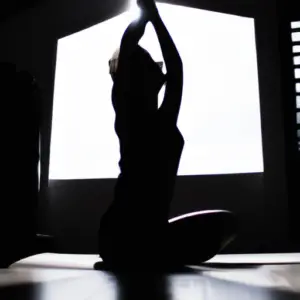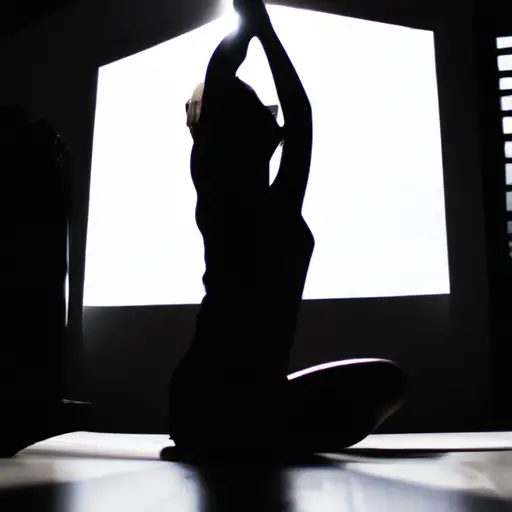Creating Perfect Lighting for Your Yoga Studio
Lighting and Yoga: Shedding Light on the Impact of Illumination
Welcome, my fellow yogis and lighting enthusiasts! Let’s talk about how the quality of lighting affects your yoga practice. Some may not think that lighting plays a significant role in yoga, but it can enhance or detract from your experience. You don’t want a harsh light to be blinding while you’re attempting your downward dog, nor do you want a dim light that obscures your movements. Proper lighting can set the mood, create the ambiance, and even impact your mood and physical performance.
Identifying the right lighting for my yoga studio: expert tips
Hey y’all, I’m excited to share with you some tips I’ve learned about identifying the right lighting for your yoga studio. After all, the right lighting can make a big difference in your practice and your students’ experience. Here’s what I suggest.
Natural Lighting:
Don’t forget about Mother Nature when trying to create the best lighting experience for your yogis. Large windows or skylights can provide the perfect source of natural light, which can enhance the mood of your studio and make it more inviting.
Artificial Lighting:
Artificial lighting may not match the natural light’s benefits, but it’s still essential to have the optimal form of it in your studio. You’ll want something that doesn’t create harsh shadows or cause eye strain, so it’s important to be mindful of the intensity and type of bulbs you choose.

Speaking of bulbs, there are various options available like LEDs, incandescent, and halogen lights, each with its pros and cons. For example, incandescent bulbs produce a warm glow, perfect for relaxation, but they’re not very energy-efficient. Other options like LEDs run cooler, save energy, and don’t need frequent replacements like halogen lights do.
Practical tips:
Now that you’ve got an idea of what types of lighting are available let’s focus on practical tips to find the perfect lighting for your studio. Here are some things to consider:
- Think about the size of the room, larger spaces may require more lighting while smaller ones look best with fewer lights.
- Create mood lighting by installing dimmers to give your studio a relaxed ambiance during the more relaxing practices
- Strategize where you’re placing your lights to avoid harsh shadows and blind spots.
Well, that’s it for now, folks! I hope these tips help you identify the right lighting for your yoga studio to create a relaxing and welcoming atmosphere. For other ideas on equipping your home yoga studio check out this fantastic article here. Namaste!
Identifying the Right Lighting for Your Yoga Studio
When setting up a yoga studio, lighting plays a crucial role in creating an ambiance that promotes relaxation and focus. Choosing the right lighting can enhance the overall yoga experience and help participants connect with their practice on a deeper level.
Types of Lighting to Consider for Your Yoga Studio
There are different types of lighting options to consider, with each providing unique benefits.
Incandescent Lights
Incandescent lights emit a warm, yellowish glow that creates a cozy and soothing atmosphere. They are also customizable, given the availability of different color temperatures and wattages. However, they are not energy-efficient and tend to emit a lot of heat, which may be uncomfortable for hot yoga studios.
LED Lights
LED lights are energy-efficient, low-maintenance, and long-lasting. They are available in a broad range of colors, making them ideal for creating different moods in the yoga studio. They are also cool to the touch, making them suitable for hot yoga studios. However, they tend to be more expensive than other lighting options.
Halogen Lights
Halogen lights operate at high temperatures and produce bright, white light. They are relatively inexpensive and provide excellent color representation, making them ideal for studios that offer color therapy. However, they are energy-consuming and may be too bright for some yoga practices.
When choosing lighting for your yoga studio, remember to consider how it affects the mood, energy consumption, and overall ambiance. It’s vital to balance aesthetics with functionality to create an inviting and comfortable environment for your yoga practice.
Practical Tips for Creating the Perfect Lighting in Your Yoga Studio
Hey guys, it’s me again! Now that we’ve identified the types of lighting options for your studio, let’s talk about practical tips for creating just the right ambiance.
First and foremost, consider the size of your room. You don’t want to overload a small space with too much lighting as this can be overwhelming. On the other hand, you also don’t want to skimp on lighting for a larger room as this can make it feel dull and cavernous.
Another helpful tip is to use dimmers to create mood lighting. This will allow you to set the tone of the room and adjust the lighting as needed during a practice. I personally prefer dimmers because they make for a softer and more relaxing atmosphere.
Lastly, take some time to strategically place your lights around the room. I’ve found that placing lights at different levels and angles can help create depth and vibrancy to your space. Also, be mindful of your lighting’s impact on wall colors, art, and decor. You don’t want your lighting to detract from the aesthetics of your yoga studio.
Overall, creating the perfect lighting for your yoga studio involves a combination of both art and science. By following these practical tips, you can create the perfect ambiance for your students to have an enjoyable and unforgettable yoga practice. Namaste!
Coming Full Circle: Shedding Light on Lighting for Yoga
Well, folks, that’s a wrap! We’ve delved deep into the topic of lighting for yoga and hopefully helped shed some light on an often-overlooked aspect of your yoga practice. After all, lighting plays a crucial role in creating a peaceful, relaxing, and energizing environment for your practice.
Remember, when it comes to choosing the right lighting for your yoga studio or practice space, there’s no one “right” answer. It all depends on your preferences, the size and layout of your space, and the mood you want to create.
That being said, it’s crucial to strike a balance between natural and artificial lighting. And don’t forget to consider different types of lighting, such as incandescent, LED, and halogen lights. Each has its advantages and disadvantages, so weigh them carefully.
And finally, always keep in mind practical tips for creating the perfect lighting in your space, such as using dimmers, placing lights strategically, and considering the room’s size. By doing so, you’ll create a yoga practice space that’s harmonious, calming, and energy-boosting for all who enter it.
So go ahead, get creative, and illuminate your practice in a way that reflects your unique style and energy. Namaste!






